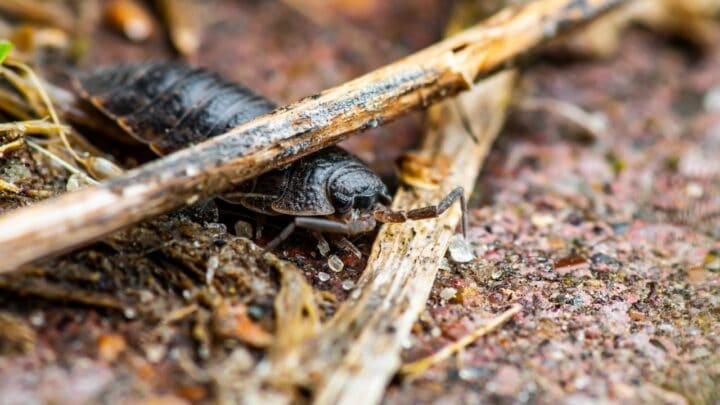I like a clean home, and one morning as I was sweeping, I found a rolled-up little crustacean in my home. It was a pillbug or isopod, also known as a roly-poly.
Having never seen one up close, I decided to place it somewhere dark and quiet and watch it for a while.
After a few moments, the roly-poly unrolled and began to amble about. I was utterly fascinated by the way in which it was figuring out where to go, and I wondered just how isopods sense the world around them.
Turning on the light triggered a much more intense reaction, and the isopod began to run at speed. Just how did it know the light was on, and why did it scurry away?
I had some questions, and I set off to my local insectologist to find the answers.
How Isopods Sense Their Environment
Some isopods have 2 antennae on either side of their head, others have 2 sets, totaling 4 antennae. These antennae are used like a blind man’s walking stick to feel out their environment, connecting with objects, reading the texture and moisture of the surrounding environment, and telling the isopod about the world around them.
Isopod Sensory Adaptation Explored
Isopods have different systems that help them to interpret their world. Unlike many insects and mammals that rely on their eyes to provide sight and sensory interpretation, isopods have antennae that guide them.
This makes an isopod similar to a centipede or other segmented insects that have antennae to detect their world with.
How Isopods See Their World
By using their antennae to read the stimuli from their world, isopods can tell what the temperature, moisture, and telemetry of their world are like.
Isopods do have compound eyes that help them tell the light spectrum from the surrounding area. It is these eyes that will cause an isopod to roll up into a protective ball, scatter when your shadow falls on them, or if you turn on the light.
With sustained darkness, your isopod’s eyes will inform it that it is now safe to emerge from its protective position and continue exploring its world.
This is why the isopod I found in my kitchen unrolled when I placed it in a dark place.
Other Senses for Isopods
Isopods mostly rely on their antennae to tell them where they should move to and at what speed.
For the most part, their antennae have two functions: to tell the isopod where it is moister as isopods breathe through land-gills that require a moist environment and to detect areas that are darkest and food-rich.
As a way to ensure they never lose their sensory abilities, isopods usually have two antennae and two antennule (or short antennae) to guarantee that if the larger antennae are severed by a predator or accident, they are still able to “see” their world.
If an isopod is no longer able to tell moisture and darkness levels of the world around them, they will die.
Isopods are land-based crustaceans that require moist, dark, and decay-filled environments to survive. They use their antennae and compound eyes to find the perfect places for them to hide such as under your home’s potted plants, among roots of plants, and in leafy compost.
I have since been placing any isopods I find in the darker corners of my garden near my leafy plants that have nice mulching to cover their roots.
A final interesting adaptation that isopods have is their ability to smell with their antennae. I found this most interesting!
Isopods, despite not having noses, are able to smell where their food sources are.
Smell helps them move in the general direction of their food source, using taxis to get there.
Or if they smell that they are moving toward a dry area with too much light, they can redirect their movement using kinesis to move in a different direction at random to reacquire the scent of a more favorable place.
Frequently Asked Questions about How Isopods Sense Their Environment
What stimuli do isopods react to?
Isopods can detect many small environmentally based stimuli. These include heat, moisture, nitrogen from fertilizers, insecticides, and flooding. Detecting these stimuli is how the isopod can read and interpret its environment. It helps them know where to move for food, shelter, and moisture. An isopod that is caught out in the open for long periods of time will eventually die from suffocation as they need a moist environment to breathe. Being in light areas where there is dry humidity will result in the isopod weakening. This is when it will need its antennae to tell it in which direction to taxis.
What kind of environment do isopods prefer?
Isopods are designed to function best in a dark and clammy environment. They are specially adapted to have antennae that can read stimuli from the world around them and interpret this into information that lets the isopod thrive. You will likely find isopods busy wiggling their way through rotting vegetation and compost with their antennae sensing and smelling the presence of food matter that the isopod can feed on.
Why do isopods prefer dark environments?
Most places where isopods thrive are dark and damp. You will find isopods in your garden beds or in the damp corners of your basement. This is their ideal type of environment: moist and gloomy. Isopods need dark and damp areas to allow their land gills to take care of their breathing processes.
The Last Isopod
Isopods are peaceful insects, and if you find one in your home, be sure to pick it up carefully and place it in your garden in a dark and damp place such as among the roots of your plants.
I am just fascinated by the tap-tap of their antennae, and knowing that this is how they see their world, I really have a newfound respect for these roly-poly crustaceans.


